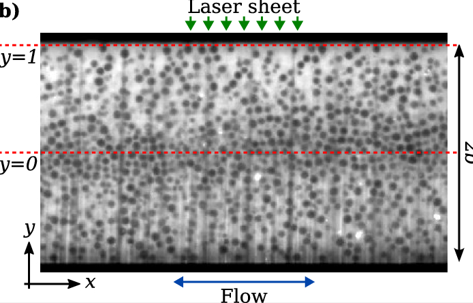EPJ E Highlight - Understanding arrangements of suspended particles in reversing flows
- Details
- Published on 13 March 2025

Experiments reveal new insights into how suspended particles rearrange themselves when the flow direction of their suspending fluid is reversed
When particles are suspended in viscous fluids of the same density, their distribution becomes uneven as the fluid is subjected to straining flows. This affects the suspension’s viscosity, especially during flow reversals. Yet although this behaviour is well understood in steady, uniform flows, less is known about how the microstructures of fluid suspensions will evolve in more complex scenarios.
Through new experiments detailed in EPJ E, a team led by Irene Ippolito at the University of Buenos Aires and Georges Gauthier at the University of Paris-Saclay have uncovered new insights into this evolving structure when a suspension’s flow direction is periodically reversed within a narrow gap.
The team’s results provide a deeper understanding of how fluids behave when mixed with small, solid particles: which can be found in scenarios ranging from industrial mixing to blood flow.
When the flow of a fluid suspension changes direction, neighbouring particles will temporarily break contact, causing a sudden drop in viscosity. As the flow stabilises in the new direction, the particles will rearrange themselves to re-establish their contacts with each other, restoring the suspension’s viscosity.
In their study, Ippolito and Gauthier’s team designed an experiment to visualise these evolving particle arrangements within an oscillating flow in the narrow gap between two parallel plates. In particular, they analysed their migration during later oscillations, when the suspension had reached a steady oscillatory state.
At this stage, nearby pairs of particles were found to be approaching each other more frequently than separating: a characteristic trait of straining flows. After each flow reversal, these approach and separation directions swapped, requiring the particles to rearrange accordingly.
Using a mathematical model to describe this evolution, the researchers also showed how the time taken for this rearrangement to occur tends to increase from the walls towards the centre. Meanwhile, the strain required for this reorganisation will decrease as the spheres become more densely packed.
However, these changes in particle arrangements happen more quickly than changes to the suspension’s viscosity. These findings show that particle rearrangements occur more quickly than viscosity changes, highlighting the need to study both parameters.
García, A.A., Roht, Y.L., Ippolito, I. et al. Microstructure response of concentrated suspensions to flow reversal. Eur. Phys. J. E 48, 7 (2025). https://doi.org/10.1140/epje/s10189-025-00472-9




